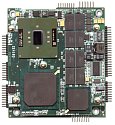OSDL releases version 3.0 Carrier Grade Linux spec
February 9, 2005Linux is achieving critical mass in a number of segments in the telecommunications market, particularly in telecom infrastructure equipment. Pointing toward an even more successful future, the Open Source Development Labs (OSDL) today released version 3.0 of the Carrier Grade Linux Requirements Definition (CGL 3.0) for developer evaluation. (more…)
 National Scientific has integrated real-time streaming video into a modular security system based on Linux 2.6 and tailored for school bus applications. The “location aware” Travado IBUS system, equipped with global positioning capabilities, logs students onto and off of the bus by using a card reader
National Scientific has integrated real-time streaming video into a modular security system based on Linux 2.6 and tailored for school bus applications. The “location aware” Travado IBUS system, equipped with global positioning capabilities, logs students onto and off of the bus by using a card reader  Parvus will soon release two PC/104-Plus CPU modules based on Intel's 400 MHz ULV (ultra low voltage) Celeron processor. The SpacePC 1451 and 1453 will target applications with high data transfer bandwidth requirements, and will support “generic” Linux.
Parvus will soon release two PC/104-Plus CPU modules based on Intel's 400 MHz ULV (ultra low voltage) Celeron processor. The SpacePC 1451 and 1453 will target applications with high data transfer bandwidth requirements, and will support “generic” Linux.  Viosoft is shipping a Linux-based hardware/software development kit intended to help developers create Internet-enabled devices or add Internet access to existing equipment. The kit bundles the company's Arriba Embedded Linux Edition development/debug tools and software with Intrinsyc's tiny PXA255-based CerfCube (pictured), and includes embedded Linux preinstalled.
Viosoft is shipping a Linux-based hardware/software development kit intended to help developers create Internet-enabled devices or add Internet access to existing equipment. The kit bundles the company's Arriba Embedded Linux Edition development/debug tools and software with Intrinsyc's tiny PXA255-based CerfCube (pictured), and includes embedded Linux preinstalled.  Renesas Technology and Arcturus Networks have teamed up on a pair of reference platforms aimed at companies developing “VoIP end-point devices.” The reference designs are based on the Renesas SH7710 SuperH processor, along with an Arcturus Linux-based session initiation protocol (SIP) based VoIP (voice-over-IP) telephony middleware
Renesas Technology and Arcturus Networks have teamed up on a pair of reference platforms aimed at companies developing “VoIP end-point devices.” The reference designs are based on the Renesas SH7710 SuperH processor, along with an Arcturus Linux-based session initiation protocol (SIP) based VoIP (voice-over-IP) telephony middleware  LinuxDevices.com today launches its fifth annual Embedded Linux Market Survey, and invites all readers to participate. The brief survey — just 20 questions — probes developer preferences and industry trends. Over the last five years, the survey has become an important resource for industry analysts and
LinuxDevices.com today launches its fifth annual Embedded Linux Market Survey, and invites all readers to participate. The brief survey — just 20 questions — probes developer preferences and industry trends. Over the last five years, the survey has become an important resource for industry analysts and 
 This paper presents Cleopatre, a library of GPL'd components that enhance scheduling, synchronization, aperiodic task servicing, and fault tolerance in RTAI or “any other RTOS,” according to the authors. The components were developed as part of a publicly funded project in France.
This paper presents Cleopatre, a library of GPL'd components that enhance scheduling, synchronization, aperiodic task servicing, and fault tolerance in RTAI or “any other RTOS,” according to the authors. The components were developed as part of a publicly funded project in France.